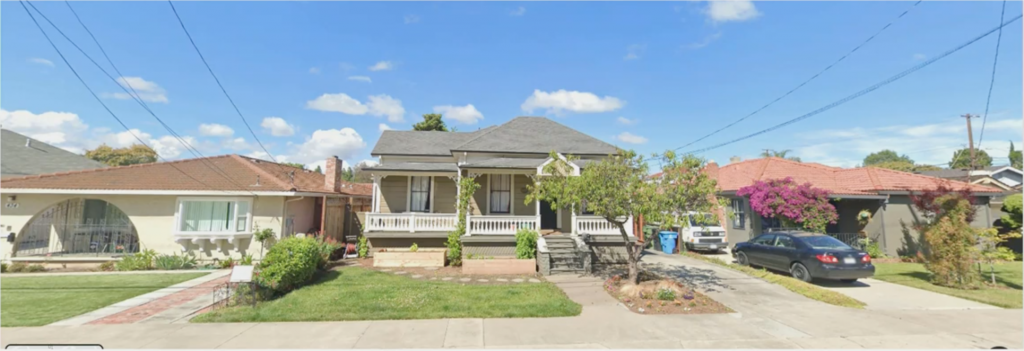Planning Commissioners heard an appeal on July 24 regarding plans for a single family home at 3533 Gibson Court. The project involved the demolition of an existing one-story, three bedroom home with a garage on an 8,112 square-foot lot, to build a two-story home with an attached ground floor accessory dwelling unit (ADU).
The Architectural Review Committee had previously approved the project with the condition that the applicant provide trees as a privacy screen to assuage concerns held by neighbors. Following the approval, the project was appealed by neighbors who said that the plans impacted their privacy, caused overshadowing in the rear of the property and was too large in massing. Although 23 residents signed a petition in support of the appeal, several other residents spoke at the meeting voicing their support for the project. Commentary grew heated at times during the meeting when the applicant and appellants issued statements.
City staff explained that the project rests on a unique lot configuration that’s narrow in the front and fans out considerably in the rear, and recommended that the project’s approval be upheld. The applicant had made changes to the plans but the appellants called for reduction in massing and the width of the second floor. Commissioners ultimately decided to uphold the project’s approval with the condition that a mature evergreen hedge be added for adequate privacy screening.
Wicked Chicken
An amendment to an existing use permit was requested for the Wicked Chicken restaurant at 2565 The Alameda so that the establishment can serve beer and wine to patrons in an outdoor seating area until 2 a.m. The applicant explained that alcohol is currently served outdoors until 9 p.m. and that the time extension would coincide with the overall hours of the restaurant. He also added that they’ve been in business for 17 years without any complaints or issues.
The amendment was approved with the condition that the extension of alcohol service until 2 a.m. only apply to Friday and Saturday nights and that performance check-ins will be conducted in six months and then one year to ensure there have been no complaints or police activity. Additionally, if a new business were to occupy the site, it would also be subject to a six month and one-year review for late-night alcohol sales.
450 Monroe Street
Commissioners voted to approve a variance from a maximum height requirement that was requested for a detached accessory dwelling unit project at 450 Monroe Street. Though the zoning code only allows for a maximum height of 14 feet for ADUs, the applicant sought to construct a two-story, 22.5-foot ADU structure in the rear yard to a main residence. The ADU would be 797 square feet with a carriage house format that was deemed in conformance with the Old Quad Neighborhood where the project is located.
Although the Historical Landmarks Commission recommended the approval of the variance, Planning staff recommended it be denied because they didn’t find any unusual conditions on the property that warranted the height variance.
“What’s interesting is San Jose allows two-story guest houses,” said Rob Mayer, the project’s architect. “I do a lot of guest houses throughout the Bay Area and a lot of them allow two stories, why? Because a lot of people don’t want to use up all their yard and we want to encourage infill.”
Neighbors spoke in support of the project saying that it’s the sort of improvement that helps bring the character of the neighborhood to life and allows for the preservation of green space and trees.
“When we have a situation where we’re applying for so many variances, obviously the zoning code ordinance is not working,” said Commissioner Priya Cherukuru.
Climate Action Plan
Planning staff updated Commissioners on the progress of the Climate Action Plan update that’s underway. The purpose of the plan update is to reflect the state’s greenhouse gas reduction target of 40 percent below what GHG emissions were in 1990. The update will also include adaptation and resiliency strategies to help Santa Clara cope with the effects of climate change such as warming temperatures and sea level rise.
The City already has in place an Integrated Resources Plan, which calls for 60 percent of Silicon Valley Power’s energy be from renewable sources by 2030. Commercial power and transportation account for 90 percent of Santa Clara’s carbon dioxide emissions, so the plan will focus on reducing emissions in those two sectors.
A Request for Proposals was issued on June 28 for a plan consultant. The proposals are due by Aug. 6, and the deadline for the plan’s completion is one year after the consultant is contracted. The plan will include at least three community engagement meetings.
Zoning Code Update
Planning staff outlined some progress on the Citywide zoning code update. New zoning district designations were drafted including high-density residential designations, mixed-use districts for commercial corridors, new office and industrial districts, a new public/quasi public district, and El Camino Real districts.
Some of the items being considered as part of the update are allowing only single appeals to City Council for all projects, refinements to single family home districts, allowing two-story ADUs and removing limits on making additions to single family homes.
The code changes are geared to encourage placemaking, streamlining the live entertainment permitting process, increasing the amount of outdoor seating allowed and re-working the process for special permits.
A study session on the zoning code update is scheduled for Aug. 20. The Santa Clara Planning Commission meets again on Wednesday, Aug. 14.
